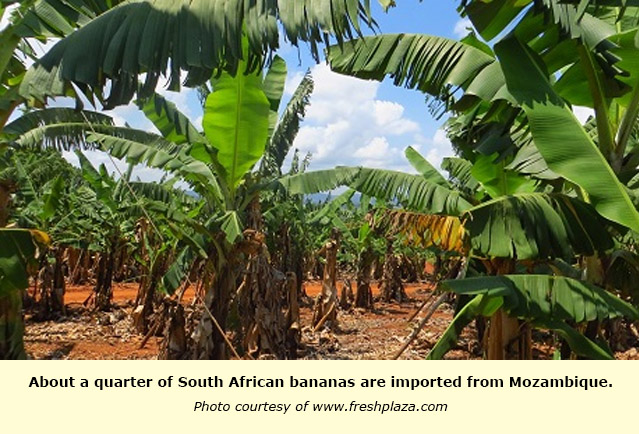The South African banana industry is currently facing a disease threat from two sides: the first is the dreaded Fusarium TR4 that was identified in Nampula Province in northern Mozambique in 2013, where it is still contained. One of the two affected farms has asked to be declared insolvent and it is hoped that bananas will never again be planted there and the other, producing bananas for export, operates under quarantine.
Banana producers in southern Mozambique produce about a third of the bananas consumed in South Africa (expected to increase to as much as half within the next ten years as production costs in South Africa rise). South African plant pathologists are working closely with these producers on biosecurity measures to retain their Fusarium-free status.
Late last year a South African agent imported a batch of bananas from one of the TR4-affected farms in northern Mozambique into South Africa, which caused some consternation. This has prompted the Fresh Produce Importers Association (FPIA) and scientists to request a revision of South African banana import requirements, a process which has been started, with ongoing discussions between the South African government and its Mozambican counterpart.
The fact that most banana farmers in southern Mozambique are either South African or have close ties with South African firms, facilitates the process of biosecurity. “Geographically the banana production area in southern Mozambique is close to the Lebombo and Onderberg production areas in South Africa, so that it is vital to protect both industries,” says Marianna Theyse, FPIA general manager.
A recent industry day in Nelspruit brought together South African and Mozambican government officials and growers with scientists from TR4 affected countries – China, Taiwan, the Philippines, Australia and South Africa – to discuss the threat and raise awareness of the disease.
Banana bunchy top virus present in KZN and Mozambique
The banana bunchy top virus is present in both Chokwe (southern Mozambique) and in southern KwaZulu-Natal. Unlike Fusarium TR4, it does not remain in the soil but is transmitted by aphids. Where water and soil are major aspects of Fusarium TR4 transmission, wind that carries aphids has a strong influence on bunchy top virus transmission.
According to Jan-Hendrik Venter, director of the Directorate: Plant Health Early Warning Systems at the Department of Agriculture, Forestry and Fisheries, banana bunchy top virus is considered as one of the four most lethal banana diseases in the world.
The fear is that the disease will reach Mpumalanga Province, where most of South Africa’s banana production is centred. In KwaZulu-Natal it has already impacted on the livelihood of rural villages, that have had to destroy infected plants, both in terms of their own food security as well as a source of income. “We’re working on campaigns to raise awareness of the disease among rural communities. If the disease is identified on young plants, it is physically easier to remove infected plants and replace with clean planting material, without losing too much production time,” he says.
The cost of disease control is high and will add to banana production costs, which is already an industry with low margins. It is a bulky product, which pushes up logistics costs.
Increasing Mozambican production for South African market
Mozambique is becoming increasingly important to secure South Africa’s banana supply (and that of Mozambique, which takes roughly a quarter of production).
According to a trader at a municipal market, if it weren’t for Mozambican banana imports, South Africans would be paying as much for bananas as consumers in Europe.
Mozambique, under Portuguese colonial rule, used to keep South Africa in bananas but relations between the newly independent Mozambique and apartheid South Africa were not warm and in 1975 the border was closed to Mozambican bananas. Like many other industries that flourished during South Africa’s isolationist years, the banana industry in the Lowveld boomed.
Around twenty years ago, commercial banana production started in the south of Mozambique because of its more favourable climate. The first expansion has since been followed by South African farmers setting up production units in the south of Mozambique, on the same latitude as their counterparts in Komatipoort and only about 100km away. Rising production costs, like electricity and wages, have led to more South African investment in banana production in the south of Mozambique.
Deeper inland, around Kiepersol in Mpumalanga Province, banana farmers are en masse converting to macadamias and avocados, either interplanting the tree crops in between bananas or removing their bananas. Land prices have risen together with the income from the high-value crops suitable to this area.
Concerns about South American imports and municipal market infrastructure
One aspect that concerns banana farmers is retailers that import bananas from Ecuador even when local bananas are available. “These imports are ridiculous, it pushes up supermarket prices because the import prices are much higher than bananas can obtain on the local market,” a banana farmer says. “It forces banana farmers to close their doors. Some of these retailers don’t realise their responsibility to the South African industry and the impact of their decisions.”
He continues: “We’re heavily dependent on municipal markets but with fewer banana farmers, there’s less pressure on maintaining the infrastructure at municipal markets to ripen and cool bananas.”
He points out that bananas are picked at a lower maturity level in South America to ensure shelf life during the four weeks of shipping across the Atlantic, resulting in lower sugars than South African bananas which can hang for longer. These tropically grown bananas are easily recognisable: they are often much larger than South African bananas, produced under subtropical conditions.
While some in the industry are deeply pessimistic about the long term prognosis of banana production in South Africa, others believe that despite a probable downward trend, the local banana industry isn’t set for total demise.
Source: Carolize Jansen, Freshplaza

